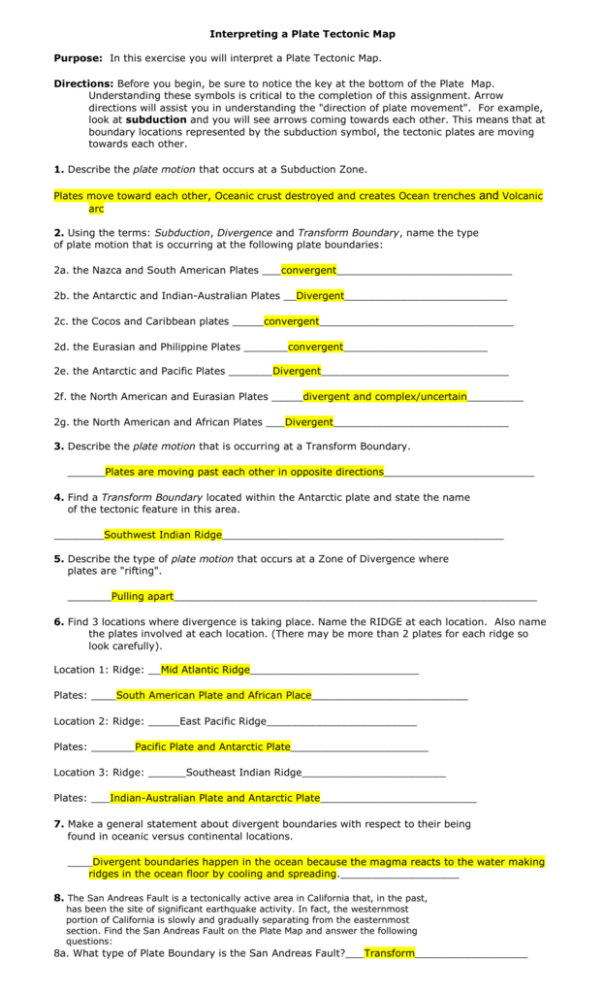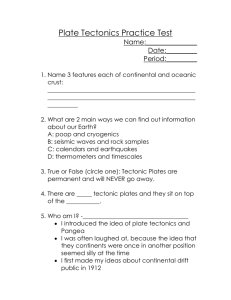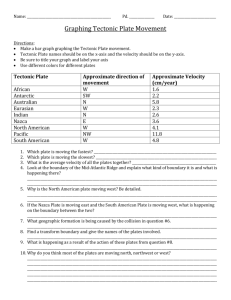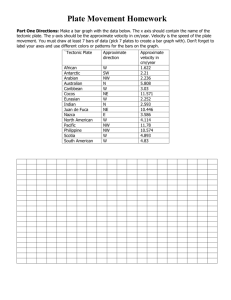Sept 9 - Assignment Answers: Plate Tectonics
advertisement

Interpreting a Plate Tectonic Map Purpose: In this exercise you will interpret a Plate Tectonic Map. Directions: Before you begin, be sure to notice the key at the bottom of the Plate Map. Understanding these symbols is critical to the completion of this assignment. Arrow directions will assist you in understanding the "direction of plate movement". For example, look at subduction and you will see arrows coming towards each other. This means that at boundary locations represented by the subduction symbol, the tectonic plates are moving towards each other. 1. Describe the plate motion that occurs at a Subduction Zone. Plates move toward each other, Oceanic crust destroyed and creates Ocean trenches arc and Volcanic 2. Using the terms: Subduction, Divergence and Transform Boundary, name the type of plate motion that is occurring at the following plate boundaries: 2a. the Nazca and South American Plates ___convergent____________________________ 2b. the Antarctic and Indian-Australian Plates __Divergent__________________________ 2c. the Cocos and Caribbean plates _____convergent_______________________________ 2d. the Eurasian and Philippine Plates _______convergent_______________________ 2e. the Antarctic and Pacific Plates _______Divergent______________________________ 2f. the North American and Eurasian Plates _____divergent and complex/uncertain_________ 2g. the North American and African Plates ___Divergent____________________________ 3. Describe the plate motion that is occurring at a Transform Boundary. ______Plates are moving past each other in opposite directions________________________ 4. Find a Transform Boundary located within the Antarctic plate and state the name of the tectonic feature in this area. ________Southwest Indian Ridge_____________________________________________ 5. Describe the type of plate motion that occurs at a Zone of Divergence where plates are "rifting". _______Pulling apart__________________________________________________________ 6. Find 3 locations where divergence is taking place. Name the RIDGE at each location. Also name the plates involved at each location. (There may be more than 2 plates for each ridge so look carefully). Location 1: Ridge: __Mid Atlantic Ridge___________________________ Plates: ____South American Plate and African Place_________________________ Location 2: Ridge: _____East Pacific Ridge________________________ Plates: _______Pacific Plate and Antarctic Plate______________________ Location 3: Ridge: ______Southeast Indian Ridge_______________________ Plates: ___Indian-Australian Plate and Antarctic Plate_________________________ 7. Make a general statement about divergent boundaries with respect to their being found in oceanic versus continental locations. ____Divergent boundaries happen in the ocean because the magma reacts to the water making ridges in the ocean floor by cooling and spreading.___________________ 8. The San Andreas Fault is a tectonically active area in California that, in the past, has been the site of significant earthquake activity. In fact, the westernmost portion of California is slowly and gradually separating from the easternmost section. Find the San Andreas Fault on the Plate Map and answer the following questions: 8a. What type of Plate Boundary is the San Andreas Fault?___Transform__________________ 8b. Name the 2 plates interacting at the location of this fault. __________Pacific Plate and North American Plate_____________________________ 8c. State the general direction that the westernmost portion of California is moving._NW______ 8d. State the general direction that the easternmost section portion of California is moving._SE__ 9. The Hawaiian Island Chain: 9a. What type of tectonic feature is associated with the formation of and also the present day eruptions on the Hawaiian Islands? _________Mantle Hot Spot: Volcano_________________________________________ 9b. Is this a tectonic feature located at the boundary of 2 tectonic plates or is it located within a tectonic plate? ___Within______________________________________ 9c. Name the plate or plates involved. __Indian Australian and North American Plate ___ 9d. Is this an Oceanic or Continental location? ___Oceanic_________________________ 9e. State the approximate latitude and longitude (with units/labels) for the Hawaiian Islands._20N,155W____ 10. Find a Mantle Hot Spot that is located underneath a large continental plate. 10a. Name the Hot Spot: ___Yellowstone Hot Spot__________________________ 10b. State its approximate latitude and longitude (with units/labels)___45N, 120W___________ 11. Iceland is unique in that it was formed from Hot Spot volcanism associated with a mid-ocean ridge that rose above the ocean's surface. 11a. Name the ridge that formed Iceland. __Mid Atlantic Ridge_____________________________ 11b. What type of plate movement is occurring at this location?_____Divergent_____________ 11c. State the approximate latitude and longitude of Iceland (with units/labels.__65N, 20W_____ 12. A geologically active area where a rifting (spreading apart) of plates is presently taking place is the East African Rift Valley. Look at northeast Africa and, keeping in mind the symbol for "divergence", name the plates involved in this splitting of the African continent. ______Arabian Plate and Indian Australian Plate___________________________________ 13. It is said that the East African Rift Valley is a product of a triple junction or, in other words, 2 separate rift zones which are dividing the African continent into 3 distinct areas. One of the rifts is located within the African Plate and is not a product of the 2 diverging plates you named above. On the Plate Map there is a symbol which indicates this other rift junction. Look at the map key and write the exact words that refer to and describe this intracontinental location. _________________Complex or uncertain plate Boundary____________________ 14. Mount ST. Helens is a famous volcano located in the Cascades, a mountain range that extend north to south and which is located to the west of the Yellowstone Hot Spot. The volcano erupted in May 1980. Its activity can be traced back to the tectonic activity of 2 plates located at a Subduction Zone. 14a. Name the 2 plates that would have been responsible for the formation of the Cascades and for the eruption of Mount ST. Helens. ______Juan de Fuca Plate and North American Plate______________________ 14b. Which of these 2 plates is the one going under the other? (Look carefully at the Map Key). _______Juan de Fuca Plate________________________________________ 15. State the latitude and longitude (with units/labels) for the southernmost and northernmost points of the Mid-Atlantic Ridge. Southern coordinates: ____55 S, 3 W______________________________ Northern coordinates: _ 75 N, 3 W_________________________________








